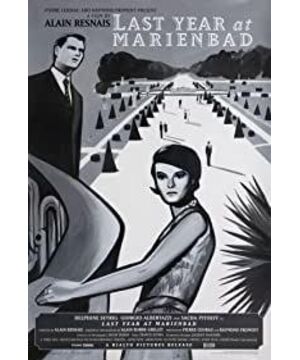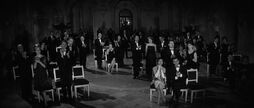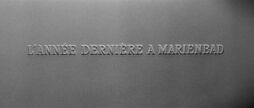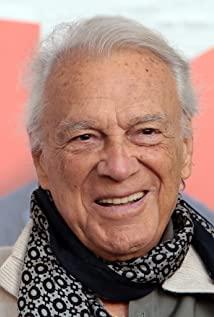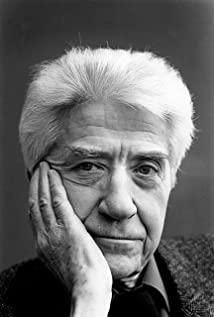The narrator’s monologue indicates that the film uses the first person, but is the narrator the character in the story? Maybe it is, maybe it is not. Some of the monologues that flashed are from the character's subjective sound (SUBJECTIVE SOUND), and some of them are VOICE OVER NARRATIVE that sounds unrelated. The two do not completely overlap, this kind of interval. It creates the illusion of multiple narrative subjects. The film first adds a layer of hazy probability from the narrative perspective. It is difficult for us to confirm whether the first-person narrator is telling his own story. The story itself is vague and the identity of the narrator is It's also vague. In fact, even the location of the story is vague. Must they meet in Marienbad last year? Maybe it is, maybe not, "maybe it happened in Frederiksbah, it happened in Karlstadt". It is this uncertain and amorphous artistic effect that fully reveals the director's interest in human thinking.
The lines occupies most of the length of the film. These lines can be summarized as the part of the conversation and the part of the character’s inner monologue. From the aggressive conversation language of the man against the woman, a mysterious story emerges. Is this man true? Met this woman in a hotel a year ago? This story was born in language. It cannot escape from the constraints of human consciousness and psychological activities. It can only be logical in a fictitious environment. Language cannot establish this story. Language cannot create facts of existence. The depiction of a situation can be temptation, inducement, psychological layout, language glaring, or even a kind of mental compulsion. Under the coercive invasion of this language, a woman becomes anxious and lost in the maze of language creation. . The director consciously emphasized the emptiness and unpredictable deception of the language world. He deals with not only the memories in the dialogue, but also the characteristics of language and the position of language in the film structure. I have to admit that the whole movie It has been created by the director into a magnificent and blurred language labyrinth, just like the well-crafted hotel where the story takes place. It is difficult for us to find an exit to the film’s mystery in the language labyrinth, because everything expressed by language may be unreal. Like the strange garden outside the hotel, it is difficult for us to know whether the hotel has an exit to this garden. The garden may be a product of imagination, because it always appears in the narrative of the character. It may be just an abstract garden.
Usually the lines are the lines in the current picture. This traditional format is broken by this film. The language and the picture do not match and are separated abruptly. Most of the content of the conversation contrasts with the picture in the memory. To be precise That is not necessarily a memory, it may only be a fiction. In the space of language, fictional plots can be unconstrained. The scenes when they met last year are constantly changing, but the narrator still narrates the same scene. He can create and break the state of affairs in memories or fictional plots at will , But the listener accepts the plot narrated by the narrator and constructs a standard prototype in his own thinking. This prototype is relatively stable and is constantly filled and perfected in the narrator’s language. This is a process that is constantly approaching reality. One party fabricates memories or falsifies without authorization, while the other party constantly pursues the truth by relying on the uncertain information from the outside. The illusion and reality here are full of variables, and it is difficult to distinguish between true and false. From the look and attitude, the man as the narrator is sincere, while the heroine who swings between doubt and belief appears erratic and lacks realism, but in the imaginary relationship between them, in their emotional interaction In the movie, the heroine’s looks and temperament are all very real. She looks like a real product born out of the virtual world. It can be seen that the director has completely drawn the boundary between the virtual world and the real world, and expresses consciousness in the language environment. .
At this time, we can say that the narrative carrier of this film is more embodied in language, which is inconsistent with the traditional film creation concept. The old concept requires the film to maintain a close relationship with the drama, and the film should be as clear as the drama. Follow through the plot. And the lack of dramatic film elements in this film caused its obscurity in structure. The dramatic mirror language was basically invisible, which weakened the role of mirror language in storytelling, and the narrative function of the lens became the babble of the lens. State, the lens expresses not the sequence of events, but the inner world of the character. It does not follow the narrative law of montage, but a kind of magical sound and shadow montage, which allows the lens to wander back and forth between reality and illusion. This kind of technical effect of overlapping reality and memory is indeed similar in form to JEAN LUCGODARD's crazy jump (JUMP CUT) technique. They do not serve a complete story. They even Destroy a complete story.
"We will not change the past", the lines that appear repeatedly in the film, and the story we see (if there is a story) is precisely the man in the film attempting to tamper with the woman's past, according to the traditional linear narrative model (LINEAR STRUCTURE). It will inevitably fall into a dilemma in form. The film breaks the deadlock of the narrative structure, and fills the NARRATIVE PAST in the structure with a large number of flashbacks and indistinguishable mirror images. What's fascinating is that the FLASHBACK here is not certain that it is in the memory. The presentation of the scene at that time may be fictitious. Since it is fictitious, it may coincide with the time point of the narrative. It may also be NARRATIVE PRESENT. This complex and multiple narrative mode greatly enriches the film. Skill, the value of director Alan Renai is more embodied in this point.
Not only the psychedelic literary language and the wonderful narrative structure, the fascination with the concept of time, the interlacing of reality and memory, the closed interior and the active inner world, the sculptural and calm characters and the turbulent thoughts and emotions, see The contradictory element is the clearest temperament of Alan Renai.
We never wanted to compromise the film with any clear meaning, we always hope it is a bit ambiguous, I don't understand why the complicated things in reality become clear on the screen. ——Alan Renai
View more about Last Year at Marienbad reviews


